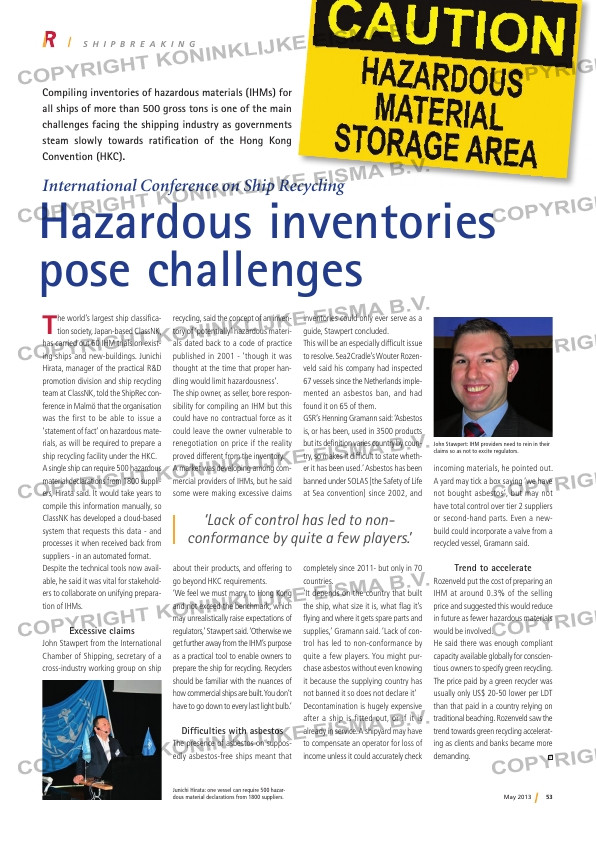Page 53 from: May 2013

53May 2013
The world’s largest ship classifi ca-tion society, Japan-based ClassNK,
has carried out 60 IHM trials on exist-
ing ships and new-buildings. Junichi
Hirata, manager of the practical R&D
promotion division and ship recycling
team at ClassNK, told the ShipRec con-
ference in Malmö that the organisation
was the first to be able to issue a
‘statement of fact’ on hazardous mate-
rials, as will be required to prepare a
ship recycling facility under the HKC.
A single ship can require 500 hazardous
material declarations from 1800 suppli-
ers, Hirata said. It would take years to
compile this information manually, so
ClassNK has developed a cloud-based
system that requests this data – and
processes it when received back from
suppliers – in an automated format.
Despite the technical tools now avail-
able, he said it was vital for stakehold-
ers to collaborate on unifying prepara-
tion of IHMs.
Excessive claims
John Stawpert from the International
Chamber of Shipping, secretary of a
cross-industry working group on ship
Hazardous inventories
pose challenges
Compiling inventories of hazardous materials (IHMs) for
all ships of more than 500 gross tons is one of the main
challenges facing the shipping industry as governments
steam slowly towards ratification of the Hong Kong
Convention (HKC).
recycling, said the concept of an inven-
tory of ‘potentially’ hazardous materi-
als dated back to a code of practice
published in 2001 – ‘though it was
thought at the time that proper han-
dling would limit hazardousness’.
The ship owner, as seller, bore respon-
sibility for compiling an IHM but this
could have no contractual force as it
could leave the owner vulnerable to
renegotiation on price if the reality
proved different from the inventory.
A market was developing among com-
mercial providers of IHMs, but he said
some were making excessive claims
about their products, and offering to
go beyond HKC requirements.
‘We feel we must marry to Hong Kong
and not exceed the benchmark, which
may unrealistically raise expectations of
regulators,’ Stawpert said. ‘Otherwise we
get further away from the IHM’s purpose
as a practical tool to enable owners to
prepare the ship for recycling. Recyclers
should be familiar with the nuances of
how commercial ships are built. You don’t
have to go down to every last light bulb.’
Diffi culties with asbestos
The presence of asbestos on suppos-
edly asbestos-free ships meant that
inventories could only ever serve as a
guide, Stawpert concluded.
This will be an especially diffi cult issue
to resolve. Sea2Cradle’s Wouter Rozen-
veld said his company had inspected
67 vessels since the Netherlands imple-
mented an asbestos ban, and had
found it on 65 of them.
GSR’s Henning Gramann said: ‘Asbestos
is, or has been, used in 3500 products
but its defi nition varies country by coun-
try, so makes it diffi cult to state wheth-
er it has been used.’ Asbestos has been
banned under SOLAS [the Safety of Life
at Sea convention] since 2002, and
completely since 2011- but only in 70
countries.
‘It depends on the country that built
the ship, what size it is, what fl ag it’s
fl ying and where it gets spare parts and
supplies,’ Gramann said. ‘Lack of con-
trol has led to non-conformance by
quite a few players. You might pur-
chase asbestos without even knowing
it because the supplying country has
not banned it so does not declare it’
Decontamination is hugely expensive
after a ship is fitted out, or if it is
already in service. A shipyard may have
to compensate an operator for loss of
income unless it could accurately check
incoming materials, he pointed out.
A yard may tick a box saying ‘we have
not bought asbestos’, but may not
have total control over tier 2 suppliers
or second-hand parts. Even a new-
build could incorporate a valve from a
recycled vessel, Gramann said.
Trend to accelerate
Rozenveld put the cost of preparing an
IHM at around 0.3% of the selling
price and suggested this would reduce
in future as fewer hazardous materials
would be involved.
He said there was enough compliant
capacity available globally for conscien-
tious owners to specify green recycling.
The price paid by a green recycler was
usually only US$ 20-50 lower per LDT
than that paid in a country relying on
traditional beaching. Rozenveld saw the
trend towards green recycling accelerat-
ing as clients and banks became more
demanding.
S H I P B R E A K I N G
International Conference on Ship Recycling
‘Lack of control has led to non-
conformance by quite a few players.’
John Stawpert: IHM providers need to rein in their
claims so as not to excite regulators.
Junichi Hirata: one vessel can require 500 hazar-
dous material declarations from 1800 suppliers.
RI-4_Shipbreaking.indd 53 03-05-13 14:03



